Why the crane whistles: the causes of noise and their
Many are faced with the problem of noise, which emit taps or pipes during their use, and this is typical not only for the old, but also for the new plumbing. The buzz that a crane makes can be quite loud and create a lot of inconvenience. We will tell you what to do if the faucet whistles, and how to solve the problem with your own hands.
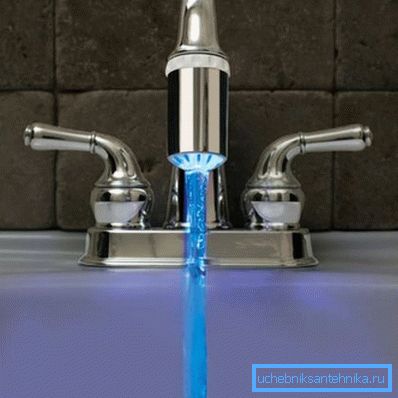
Causes of noise
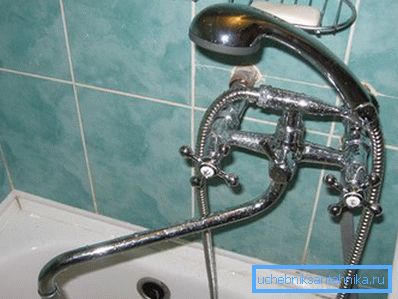
Most often noise occurs in mixers and locking mechanisms of cranes due to the phenomenon of hydrodynamic cavitation.
Cavitation is a process that occurs when the pressure in the liquid decreases and the subsequent occurrence of bubbles or cavitation cavities (cavities), which then collapse when pressure is equalized, releasing energy in the form of a shock wave and sound.

If the valve is working properly, then when it is opened, the transition process with a significant pressure drop in the fluid flow lasts a very short time, and the noise almost does not occur.
However, due to the wear of the gaskets, a local differential effect can be observed, where cavitation cavities with a characteristic roar or whistle will form.
Also, the cause of the noise can be a poorly fixed external pipe in the place of its narrowing, which, during the passage of water flow, enters into resonance and begins to oscillate, making low-frequency sounds.
In this case, it is enough to fix the pipe in a fixed position with the help of additional brackets or gaskets. Often this problem is observed in flexible hoses that are connected to the mixer.

If you hear a noise in the bathroom when opening water, you should do a few things:
- Determine which crane is making noise. To do this, alternately open the hot and cold water valves, and in this way identify the source of the sound;
- Determine the type of crane box (head). This is done simply: if for opening it is necessary to make two or more turns of the valve, it means that you have a valve with a rubber gasket. If unlocking requires no more than a turn - your faucet is equipped with a ceramic head;
- If the noise occurs somewhere under the sink, then the flexible hose makes a noise. It will have to tighten and fix in any convenient way.
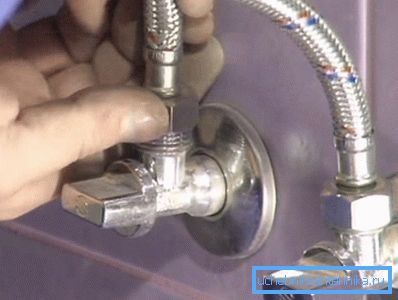
Note! Most often the culprit noise becomes a worm crane-box due to wear rubber gaskets. However, the ceramic head may make noise, since the silicone ring may subside and the bush will become less dense.
Elimination of whistles
Rubber head
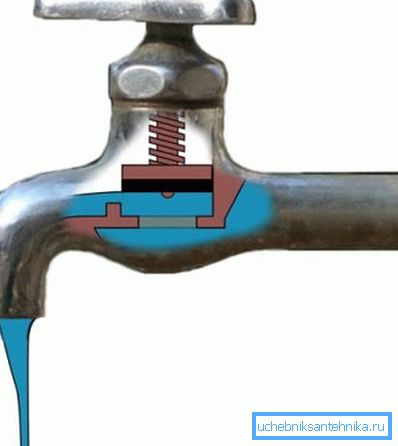
So, the mixer is buzzing in the kitchen, you alternately opened the hot and cold water taps and determined the type and source of the noise.
Further, the instruction is quite simple:
- Remove the cap on the valve and unscrew the screw that holds the flywheel;
- Remove the flywheel, remove the cover and the adapter sleeve;
- Using the key, carefully unscrew the crane;
- If the gasket is old - we change it to a new one, if it is in good condition - we cut its edge at a 45-degree angle to a depth of 1 mm;
- Putting the crane back. The noise should disappear;
- If the noise does not disappear, we change the crane to a ceramic crane.
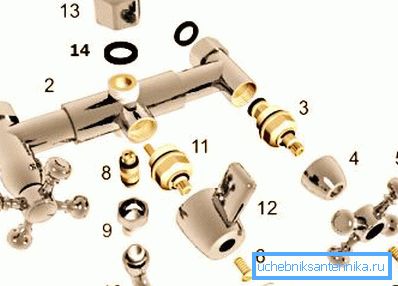
The most common cause of whistling becomes a worn rubber gasket, and it is enough to simply replace it. It can also help chamfering at 45 degrees, but the most rational solution would be to replace the axle box with a ceramic one, especially since its price does not exceed a few hundred rubles.
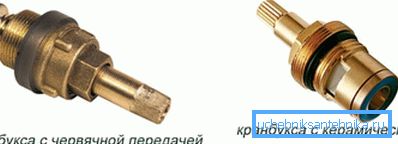
Note! To replace the axle box, you need to come to the plumbing shop with an old head and, with the help of the seller, select the part that fits the size and installation method. Similarly, a new gasket is selected.
Ceramic head

If your faucet has a ceramic faucet, but it still makes unpleasant sounds, the cause of this phenomenon may be a sagging silicone ring.
To eliminate the noise, it is necessary to disassemble the mixer and replace the part, you can also put a similarly shaped ring of thick polyethylene.
The procedure for disassembling a crane is almost the same as disassembling a valve with a worm-crane: remove the cap, unscrew the screw of the flywheel, remove the flywheel and unscrew the head with ceramic discs.

Then you can disassemble the head itself and attach an additional ring of thin plastic (no more than 0.5 mm) or polyethylene, but it is better to simply replace the part with a new one.
If you have a modern faucet with a single lever mixer, then the presence of a whistle is something from the realm of fantasy.
But if it still makes noise, then you should simply replace the cartridge:
- remove the lever;
- decorative cover;
- unscrew the cartridge mounting nut;
- take out the cartridge itself.
We go to the store and buy a new one with the same size.

Note! Most often, the faucet with the cartridge is noisy due to the inconsistency of the inlet pressure of the pipes with the calculated parameters. In this case, you will have to change the mixer to a more “compliant" one or install a pressure reducer.
Conclusion
"Singing" taps - a fairly common problem. It is solved relatively simply by replacing the gasket or crane box. The video in this article will help you see the process with your own eyes and prevent mistakes during work.